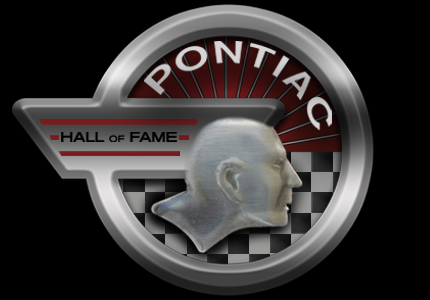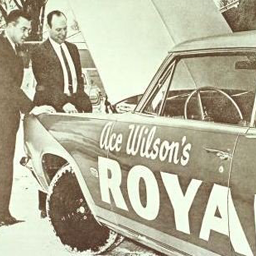Ace Wilson's Royal Pontiac
Times Nominated: 2
Nominated Year(s): 2018, 2019
Last Year of Eligibility: 2023
Category: Pontiac Entrepreneur
His father, Asa Wilson Sr., decided to get the young man off the streets he would buy him a Pontiac dealership.
The Wilson family was quite wealthy and made its money from a large and very successful dairy called Ira Wilson and Sons. Wilson Jr. went on to become one of Pontiac's most profitable dealers and, of course, his Royal Bobcats are now legendary.
The younger Wilson loved racing, but never did any organized drag racing, said Jim Wangers, the godfather of Pontiac's GTO, who is now 80 and still working at his company in Oceanside, California.
In 1959, Semon "Bunkie" Knudsen was named general manager of Pontiac which, up until only a few years before that, was selling stodgy cars and the word "performance" was not in the company's vocabulary. Despite that image, "The 347-cu.in. V-8 came out in 1957, and that kind of started the performance era," Wangers said. "But Bunkie told a group of engineers he wanted 100 more horsepower out of the V-8. This lead to the development of over-the-counter high-performance parts in 1959," said Wangers, who at the time was an advertising executive for Pontiac's ad agency, McManus, John & Adams.
To further sell his idea to top GM management, Knudsen contacted Wangers, who assembled a team of a salesman, service manager and parts man to travel to all 27 Pontiac zones to try and sell performance, said Wangers, who called his program the Performance Seminar. He said each seminar lasted about three days.
"Our job was to educate the dealers about performance. About 90 percent of Pontiac's dealers didn't even know we had high-performance parts available. It was our job to inform them of that but, more importantly, how they could make money by doing so."
Well, Knudsen hit a roadblock when Pontiac's vice president of sales, Frank Bridge, shot down the idea. Wangers described Bridge as a very good salesman, but totally against performance in any sense of the word. Not wanting to rock the applecart and fearing retribution from upper management, Knudsen killed the plan, but pulled Wangers aside and told him he loved the idea. "He told me to go out and find a dealer willing to take on the task and that Pontiac would be "friendly" to that dealer.
Wangers first went to Bill Packer Jr. of Packer Pontiac, but he said he had to talk to his dad first. That didn't work out. Wangers went to Ace Wilson Jr. and gave him the sales pitch. "He was so enthusiastic about it he went ballistic and would not let me out of his office until he signed a contract," Wangers recalled. "I told him besides selling high-performance parts, he had to put a car on the dragstrip and he did."
With factory support, Royal successfully campaigned a 1959 Catalina in National Hot Rod Association drag racing. On Labor Day 1960, Royal-tuned Super Dutys won three races at three venues.
The old adage, "win on Sunday, sell on Monday'' certainly applied to Royal, and customers seeking high-performance Pontiacs came in droves to the Royal Oak, Michigan-based dealership. The term "Bobcat" was coined by Wangers and Wilson loved it.
"About 99 percent of the Bobcats we sold were Catalinas back in the early days. We had to come up with a special emblem so we took the letters we needed to spell BOBCAT from the block letters PONTIAC and BONNEVILLE and they fit right into the pre-drilled holes on the Catalinas." In the early 1960s, Ace Jr. was driving a black Grand Prix with a supercharger he had his mechanics install. "He loved convertibles and his three-martini lunches," Milt Schornack recalled. Schornack was one of those mechanics, along with Dave and Sid Warren and others.
At his peak, Ace's dealership was selling more than 1,000 Royal Bobcat conversions per year. "Our best year was 1966 with the GTO and some of the Grand Prix. Wilson sold many more Royal Bobcat kits through the mail and, in essence, became the first high-performance mail order dealer." In 1968, Royal started installing 428 engines into GTOs, a practice forbidden by GM. By 1969, Ace had had enough of the "internal" resistance from his father and the general manager, Tom McQueen, who also hated performance and wanted nothing to do with it. So, in 1970, he sold his Royal Racing Team to John DeLorean's brother, George, who owned Leader Automotive.
Here's a Bobcat package: Rocker arm locking nuts; new rocker cover gaskets; thinner head gaskets by 0.022-0.025 inches, to increase compression; rocker cover gaskets; blocked heat riser gasket; carburetor re-jetting package; distributor re-curve kit, which included Mallory points and condenser and a new advance stop with lighter weights and springs and two Royal Bobcat emblems.
There is a club dedicated to the memory of the Royal Bobcats run by Dr. Eric Schiffer, a chiropractor, who treated Ace Wilson Sr.--Wilson Sr. died about five years ago in his late 90s, Schiffer said.
Like Wangers, Schiffer said Wilson Sr. hated performance cars and just bought the dealership for his son. There was a family feud, of sorts, between Ace Sr.'s brother, Ira, and Wilson Jr. "He basically thought Jr. was a screw-up," Schiffer said.
By 1974, he was totally burned out from the dealership and, because of a hard lifestyle of drinking and living on the edge, he moved to northern Michigan to pursue real estate development. He died in the late 1980s from an inoperable tumor in his throat, Schiffer said. Today, a Pontiac-Buick-GMC dealership remains at the Royal site and the current dealer, Jim Fresard Pontiac-Buick-GMC still uses the old Royal service bays.











